AMD's A10-5750M Review, Part 2: The MSI GX60 Gaming Notebook
by Dustin Sklavos on June 29, 2013 12:00 PM ESTDisplay Quality
High dpi displays, even if they're TN panels, tend to perform fairly well, and the 1080p 15.6" panel on the MSI GX60 is at least a healthy one. I feel like at long last we're finally starting to come out of the dark ages of 1366x768 panels; virtually none of the notebooks I've tested recently have had bad or low-resolution panels. With tablets pushing pixel density ever higher and TN panels only showing up on the cheapest of the cheap, the notebook industry has been running out of excuses to fob crappy displays on us. You'll still see them at the lowest and most mainstream price points, but the trickle-down mercifully seems to have begun.
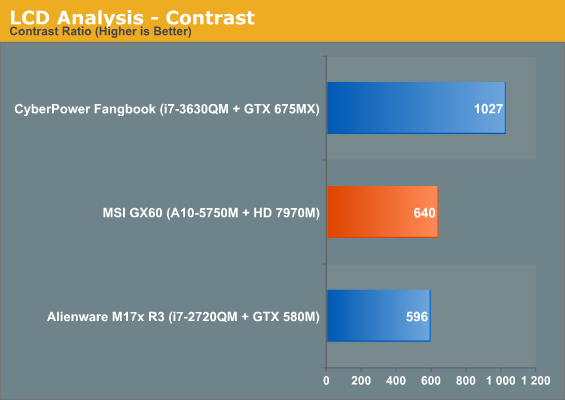
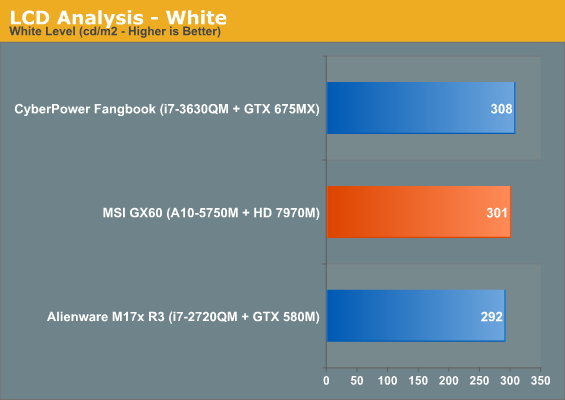
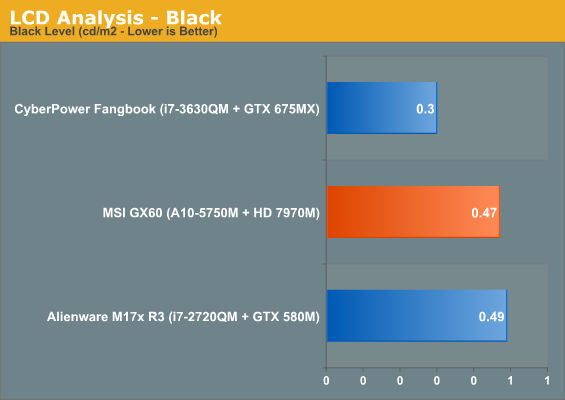
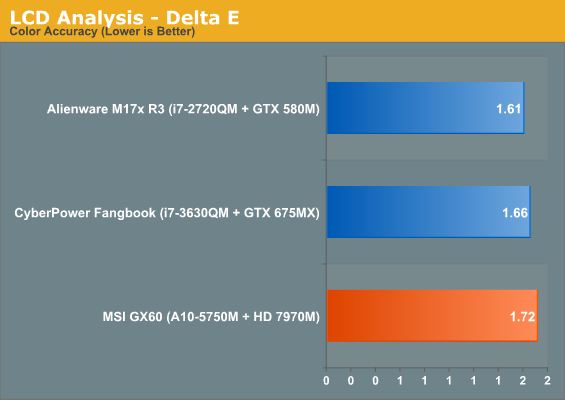
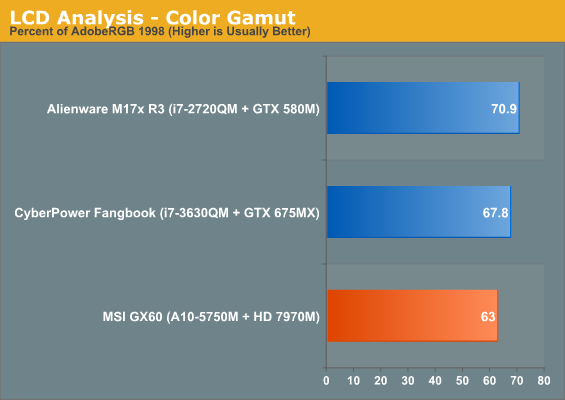
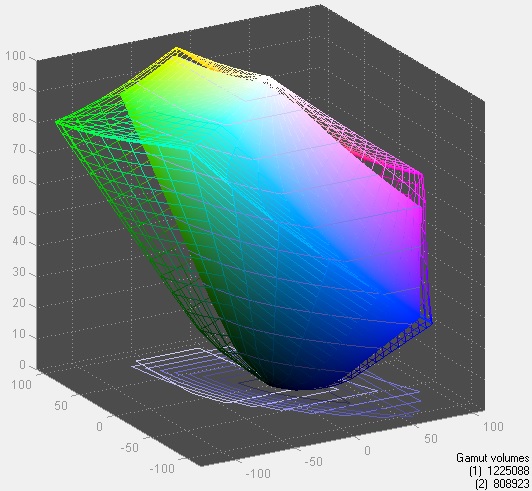
The panel MSI uses for the GX60 isn't exemplary, but the contrast ratio is a far cry from the sub-300 or even occasional sub-200 TN panels of the entry level market. If nothing else, the 1080p display is more than adequate for both gaming and any basic work, and I appreciate that MSI has stuck with the trend in the gaming notebook market of moving towards matte panels. Alienware was the last holdout, but their refreshed line of notebooks doesn't feature glossy displays either.
Battery Life
Unfortunately, perhaps frustratingly, we weren't able to get battery running time results for the original Trinity-based GX60, so MSI's new Richland-based model is stuck in the wilderness. Jarred has also reported continued issues with AMD's Enduro technology, but my experience with it on the GX60 was actually pretty painless. Enduro's interface is still miles behind NVIDIA's Optimus, but I at least have hope now that AMD will be able to compete and level the playing field. As it stands, NVIDIA hardware has been ubiquitous in the notebook space. While that's good for them, consumers need choice and competition.

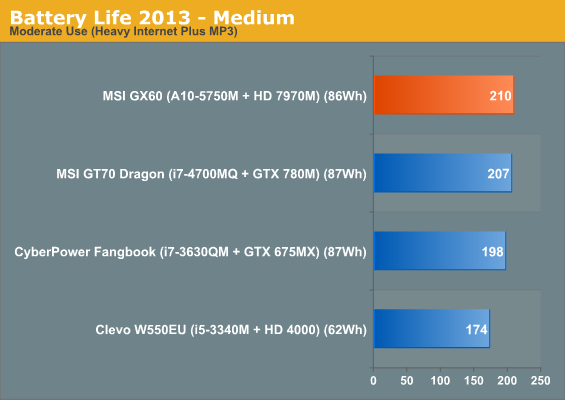

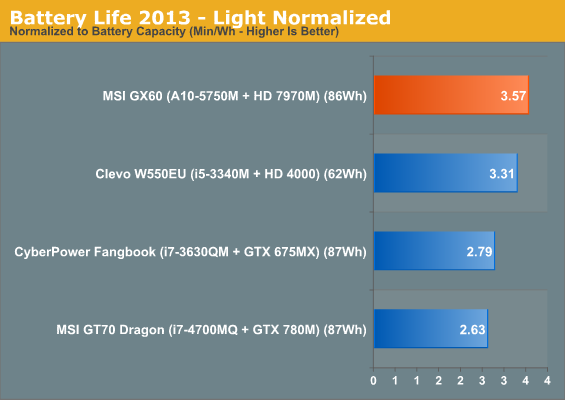
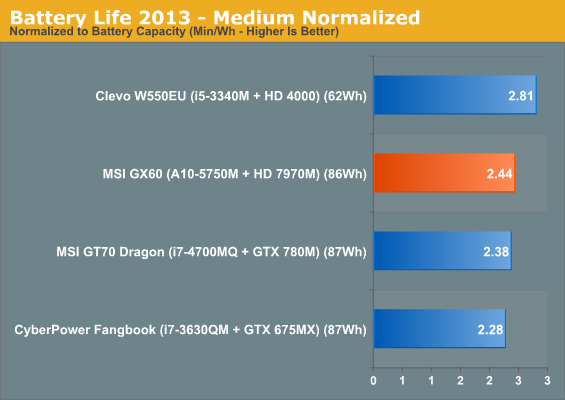
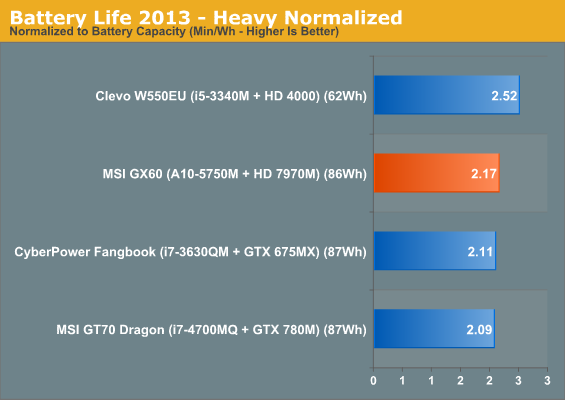
Compared to the other gaming notebooks tested and even the lone Clevo ultrabook, the MSI GX60 is able to actually produce pretty excellent battery life. If all you're doing is casually surfing the internet, the Richland-based APU powering the GX60 can give you a solid five hours of running time.
Heat
While the larger GT70 Dragon Edition had trouble managing its thermals (hopefully fixed with a BIOS update, more on this to come soon), the GX60's dealing with a much lower thermal load. The Intel Core i7-4700MQ coupled with the GeForce GTX 780M results in a peak power draw of almost 150W between the CPU and GPU, while the GX60 tops out at 110W.
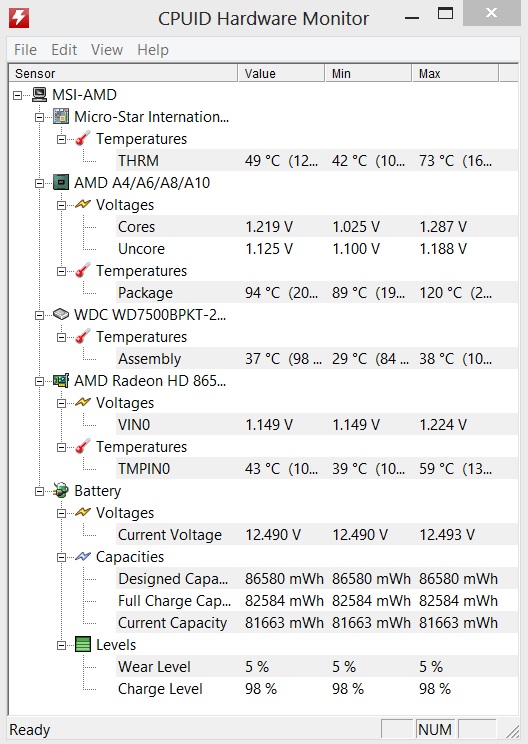
I'm not sure what HWMonitor is reading as the "package" temperature, but I can tell you that's not what the APU is running at. For a better idea of how hot the system is running, take a look at the "THRM" value and the temperature value under the Radeon. The GX60 has no trouble dissipating the heat from the A10-5750M and Radeon HD 7970M.










69 Comments
View All Comments
Darksurf - Saturday, June 29, 2013 - link
I can already see one reason why you had poor benchmarks. You are only using one stick of DDR3?! WHY? AMD APUs depend heavily upon dual channel.Bull Dog - Saturday, June 29, 2013 - link
Clearly, you didn't read the article.Samus - Saturday, June 29, 2013 - link
Darksurf, even if they ran the tests with one DIMM, why would discrete graphics be impacted by a single memory channel?popej - Saturday, June 29, 2013 - link
As I understand, video data form discrete GPU is transferred over PCIe to internal video buffer of APU, eating some memory bandwidth.Pity there is no comparison with dual channels configuration.
Alexvrb - Monday, July 1, 2013 - link
Not only are they only using a single channel, they're using DDR3-1600. The 5750M is unique in AMD's mobile lineup in that it supports DDR3-1866 out of the box - none of the Trinity mobile chips (or lesser Richland models) can claim this. Now granted, when relying on the discrete graphics this isn't going to make as big of a difference. But there will be some improvement running dual channel 1866. I also have to wonder if Enduro is causing issues as well.I know they're trying to keep costs down, but I can't help but wonder if they'd be better off with a significantly cheaper model using a slower discrete GPU, perhaps even dual graphics.
thesavvymage - Saturday, June 29, 2013 - link
this laptop only HAS one slot for ddr3. Read the article before commentingthesavvymage - Saturday, June 29, 2013 - link
edit: has one ddr3 in it by stockperse - Thursday, January 23, 2014 - link
actually that depends where you buy it from. The one i bought has 2x4GB besides that i must say while alot of people are bashing this pc, i love it. Design of the case, ease of access to all parts, heat management are best i have ever seen in any laptop. Performance is bottlenecked by the cpu ofc but not as much as everyone are saying. My friend bought i5+nvidia 7xx series card, not sure which exactly and performance in most games is very similar, while he paid 150€ more for his.I think benchmarks are also heavily influenced by drivers and switchable graphics compatibility.
Darksurf - Monday, July 1, 2013 - link
I did read the article. I was baffled by the poor results and went back to the front to see if I missed something and I saw " 1x8GB A-Data DDR3-1600 ". Thats when it immediately realized a problem. If this laptop only has one slot for DDR3 then this design was hampered from the beginning and ready to limp to the starting lines.Latest APUs have been given a boost to support up to 1866mhz. Because the GPU IS discrete it heavily depends on the RAM as there is no "dedicated memory" for the GPU. I'll wait to buy a laptop, and get one when AMD lightning bolt is released and I can buy a laptop with a richland APU and 1866mhz memory.
relztes - Monday, July 1, 2013 - link
That's incorrect. The 7970M has 2 GB of GDDR5 on a 256-bit memory interface. So the single channel memory is dedicated to the CPU only, and shouldn't hurt the 7970M performance.Still, I don't really understand the point of pairing an APU with discrete graphics. I think as a combination of CPU + low end GPU, AMD's APUs are a great value. It makes a lot of sense in a laptop where you don't want the extra heat and power requirements of a discrete GPU to trade a little CPU performance for superior integrated graphics. But if you add a 7970M, then it makes sense to prioritize the CPU over the integrated graphics. Save Richland for where you need the integrated graphics.